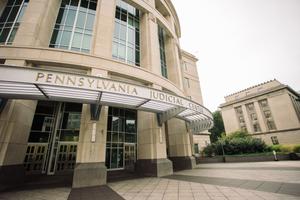This article is part of a yearlong reporting project focused on redistricting and gerrymandering in Pennsylvania. It is made possible by the support of Spotlight PA members and Votebeat, a project focused on election integrity and voting access.
Updated March 17, 2022: The Pennsylvania Supreme Court has rejected the legal challenges to the state’s new legislative maps. The redistricting process is over.
HARRISBURG — Pennsylvania’s new political maps may have been picked, but that doesn’t mean the redistricting process is over.
There are pending legal challenges against the congressional and legislative maps, which were redrawn this year to account for population changes identified by the census.
Below is a rundown of what you need to know about these lawsuits. If you want to learn more, watch Spotlight PA’s free expert panel on the subject.
Last updated March 10, 2022
Congressional map
Pennsylvania law gives the responsibility to draw the state’s congressional boundaries to the legislature. The governor has the power to approve or reject the map.
Gov. Tom Wolf did the latter in January when he vetoed a map sent to him by Republicans.
Shortly after that occurred, the state Supreme Court agreed to intervene in an existing case and take over the process. In mid-February, the justices in a 4-3 decision picked a new congressional map from among more than a dozen proposals.
But there’s still at least one legal challenge left to play out.
A group of Pennsylvanians, including two Republicans running for political office, has brought a challenge in federal court, arguing the Pennsylvania justices had no right to pick a new map.
A federal judge in Harrisburg denied their request for a temporary restraining order against the map, while the U.S. Supreme Court declined to intervene. A lower court hearing has yet to be scheduled.
>> MY MAP: Search now to see your old and new political districts
Legislative maps
Pennsylvania’s state House and Senate districts are drawn by the five-person Legislative Reapportionment Commission, which is composed of the top General Assembly leaders and an independent chair.
The panel voted 4-1 in early February to approve new maps.
Under the Pennsylvania Constitution, any person could bring a challenge to either map directly to the state Supreme Court by March 7. The court will now choose whether it wants to consider any of them.
Nine separate parties brought challenges, including several that specifically target the ways certain areas were divided.
One group of Butler County residents — potential legislative candidate Ryan Covert, his mother Darlene J. Covert, and supporter Erik Hulick — are challenging how the state House map divides their home county.
Voters in Delaware County claim there are unnecessary splits there and an overall “subordination of the reapportionment criteria,” in part due to a focus on partisan data.
Jackie Hutz, a resident of Butler County, critized the changes made from the preliminary plan to the final one and alleged the changes were made for partisan reasons. The challenge went on to label the process an “abuse of office” and “misapplication of government resources.”
Todd Elliott Koger claims he was drawn out of a state House district in Pittsburgh in order to benefit another candidate who works for Senate Minority Leader Jay Costa (D., Allegheny), a member of the Legislative Reapportionment Commission. In a statement, Costa called the accusation “offensive and completely inaccurate.”
“I would not and did not use my role on the LRC to make a House seat more favorable to a member of my staff,” Costa continued.
A group of math and science professors from Pennsylvania universities who challenged the congressional map-making process and submitted their own proposal have also objected to the legislative maps, singling out the Senate map.
“It splits more political subdivisions than ‘absolutely necessary,’ and it violates the guarantee provided by the Free and Equal Elections Clause that all voters have an equal opportunity to translate their votes into representation,” the group wrote.
Former and current elected officials also brought challenges.
Edward Kress, a former Republican Allegheny County Council member, alleged that Pittsburgh and the surrounding area were divided too many times. Kress singled out Wilkinsburg borough — a predominantly Black municipality — which was separated from Pittsburgh in the House map.
State Sen. Lisa Boscola (D., Northampton) is objecting to the way her district in the Lehigh Valley was divided.
House Majority Leader Kerry Benninghoff (R., Centre), the only member of the Legislative Reapportionment Commission to vote against the maps, wants the court to throw them out. He claims the maps were gerrymandered to benefit Democrats and create districts that do not comply with the Voting Rights Act.
And Eric Roe, a former Republican representative from Chester Couty who pushed to create an independent redistricting commission, claims the House map does not fulfill neutral criteria, like having equal population.
WHILE YOU’RE HERE… If you learned something from this story, pay it forward and become a member of Spotlight PA so someone else can in the future at spotlightpa.org/donate. Spotlight PA is funded by foundations and readers like you who are committed to accountability journalism that gets results.
